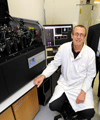September
New research equipment will track cancer spread

New technology which will provide an insight into how cancers spread around the body and how effectively treatments are working has been unveiled by Newcastle University.
The ImageStream Imaging Flow Cytometer called an ImagestreamX (ISx), allows scientists to see cancer cells that may be circulating in a patient’s blood and is able to analyse up to 4,000 individual cells a second, and has been funded by the Sir Bobby Robson Foundation.
The ISx is housed in Newcastle University’s Northern Institute for Cancer Research in the Paul O’Gorman Building, which, coincidentally, was officially opened by Sir Bobby Robson on 21 February 2005.
The ISx works like a microscope taking high quality fluorescent images after cancerous cells in a blood sample are tagged with a fluorescent marker. Researchers can then identify cancerous cells that may have become separated from a tumour so they can study whether they are responsible for the spread of cancer around the body.
It will primarily help with the drug trials being undertaken in the Sir Bobby Robson Cancer Trials Research Centre at the Northern Centre for Cancer Care, Freeman Hospital in Newcastle.
Officially announcing the purchase of the ISx is a proud day for Lady Elsie and supporters of the Sir Bobby Robson Foundation.
Lady Elsie says: “The science involved with new cancer research is incredible really. We’re moving forward all the time and that’s as it should be.
“It’s a great privilege and a great responsibly being involved with the Sir Bobby Robson Foundation. So many people continue to help raise money to support our work and on days like this it’s good to be able to show them how their support is making a difference.
“This new equipment will help patients in the Sir Bobby Centre and I understand the Leukaemia Research Group will also find it very helpful. It’s something the medical trustees of the Foundation strongly recommended we buy and it’s wonderful to see it up and running.”
This is the first ISx in the UK that has been purchased specifically to detect and characterise tumour cells as they travel around the body in the blood stream. Known as Circulating Tumour Cells (CTCs), they are incredibly rare and a typical blood sample contains approximately 60 million white blood cells, 50 billion red blood cells and as few as five CTCs.
There is growing evidence that the presence of five CTCs is associated with a worse prognosis for the patient so their detection is important.
The information the machine provides will be vital to scientists who are studying whether changes in the number CTCs are a predictor of how well a patient may respond to treatment. If so, they will be able to identify which patients will benefit from particular treatments.
Dr David Jamieson is a Research Associate at the Northern Institute for Cancer Research and will be using the ISx.
Dr Jamieson says: “We’re all so pleased to have this new Imaging Flow Cytometer. It will make an enormous difference to our work and we’re very grateful to the Foundation’s supporters for making it happen.
“Many of the drug trials at the Sir Bobby Robson Centre are being used in patients for the first time and new drugs are designed to work in a specific way in tumour cells. We want to use CTCs, rather than white blood cells or normal skin cells, to work out whether the drugs are working as predicted.
“The ISx has many other important uses too. As well as the detection of CTCs, it will be very useful to leukaemia researchers as well as in many areas of laboratory preclinical research.
“It can collect pictures of tens of thousands of cells with up to 10 different proteins stained with fluorescent antibodies. Crucially, this means very small changes in cells can be observed.
“For example, a drug may be expected to result in the movement of a protein from the cytoplasm to the nucleus and the images from the ISx will allow us to see these changes.”
The Sir Bobby Robson Foundation provided £438,000 to buy the ISx and its purchase has only been possible thanks to tremendous ongoing support for the charity from thousands of individual fundraisers and help from the Newcastle Building Society, which has made a record contribution of £0.5million to the charity in the last year.
published on: 4 September 2013
